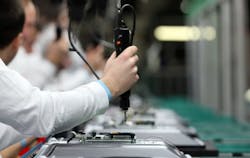When Anna-Katrina Shedletsky was working as an engineer at Apple, she often found herself traveling overseas and spending weeks at the factory to fix a problem on an electronics assembly line. Finding the root cause of an anomaly can be like finding a needle in a haystack. It is a highly manual failure analysis process that can cause significant delays to the schedule.
And, when it comes to producing product, time is money. Not to mention the small window of opportunity once the product hits the market. For example, the Apple AirPods wireless earbuds shipped a few months after the release of the iPhone 7, which had no headphone jack. A costly—and somewhat embarrassing—problem.
Luckily, Anna, who was the product design lead for Apple Watch, wasn’t part of the AirPods debacle. And, actually, she wasn’t part of Apple at all at the time; she was busy launching her own business creating a system that will help electronics companies identify and fix assembly problems much faster. Drawing from her and her colleagues’ experiences spending hundreds of days at manufacturers responsible for millions of Apple products, she and her team have a deep understanding of the inefficiencies in the new product development process—and the value of not having to travel far from home. To that end, the product Shedletsky designed can remotely analyze anomalies on the line.
Shedletsky is the co-founder and CEO of Instrumental. Established in May of 2015, the California start-up has raised $10.3 million backed by Eclipse Ventures, First Round Capital and Root Ventures. What’s unique here is that the hardware/software product leverages machine learning to identify problems quickly.
The system includes inspection stations and software tools that enable engineers to remotely review images of any unit, while virtually tearing down a device to understand what went wrong, take measurements, communicate with the global team, and make fixes or specification changes to stop delays before they start.
Here’s how it works: First, inspection systems take a lot of images of the product while on the assembly line. Then, it makes those images remotely searchable and comparable. And, lastly, it applies learning and reacting to assembly line data so engineers can prevent further issues.
The machine-learning feature, called “Detect” and which launched this month, highlights units that appear defective, giving customers a significant edge in resolving product issues.
“Detect uses Convolutional Neural Networks, a machine-learning technique, to process hundreds of units and identify the most interesting units to review in seconds,” Shedletsky said. “Detect requires no foresight of what might go wrong, no training, and no golden units. It works on both small and large datasets.”
When used in combination with other Instrumental software tools, an engineer can identify an issue and then take the next step by virtually disassembling concerning units and even taking measurements to understand what is wrong. These remote and on-demand first pass failure analysis tools save significant time and communication between companies and the factories that make their products.
And, while Instrumental Detect automatically processes hundreds of units and identifies the most interesting issues in seconds, in the near future, the company will begin alerting engineers directly when it discovers anomalous units.
With the Instrumental system, teams can:
•Triage defective units automatically
•Restart downed lines hours or days faster
•Identify root cause in minutes
•Test hypotheses without building more units
•Monitor and set cosmetic specifications remotely
•Keep teams aligned around the globe
Right now, the company is putting a lot of effort into electronic manufacturing, but they are expanding quickly to any brand building serialized units. According to the company, Instrumental customers, including Fortune 500 companies, have used the system to virtually disassemble 16,000 units and to take over 40,000 measurements, all remotely. Multiple customers have saved over $350,000 in the first several months by using Instrumental to respond to issues, the company said.
“There’s no going back; robotics and automation have already changed manufacturing. Intelligence like the kind we are building at Instrumental will change it again,” Shedletsky said. “We can radically improve how companies make products today and we hope to soon fundamentally change manufacturing as a whole.”
About the Author
Stephanie Neil
Editor-in-Chief, OEM Magazine

Leaders relevant to this article:
